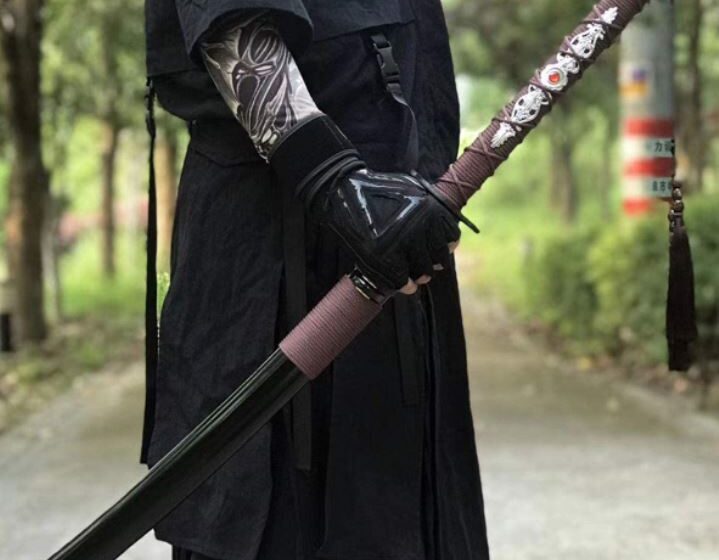The Hamon appears as a trail that is milky in color and runs along the edge of the blade. It is the end consequence of the katana’s cutting edge being hardened through heat treatment or tempering. Each line that the Hamon creates is named as a general pattern, and occasionally represents a school or even a smith. Although there are various variations, straight Hamon is the most common.
Although some believe that swordsmiths made Hamons for aesthetic reasons, this isn’t always the case. A Japanese sword’s blade may have the distinctive Hamon design running along half or the entire length. Hamons undoubtedly have an aesthetic component, but differential hardening, another sword smithing process, is where they came from originally.
History Of Katana Blades
“Yaki-kara” denotes the region closest to the mune (blade’s opposite side), which is the pattern’s top, “Yaki-no-Tani” denotes the region closest to the blade, which is the pattern’s bottom, and “Koshi” denotes the slope from the head top to the valley.
Section 1 or 2 cm from the bottom of the ha-machi, known as Yakidashi, reveals the features of the time and the school as the blazing blade of a Japanese sword begins there.
Creation Of Hamon
Differential heat treatment was a crucial component of traditional Japanese swordsmiths’ production processes. The swordsmiths rarely went out of their way to make a Hamon. Instead, it was a side effect of differential heating.
As a result, they could produce swords with a powerful edge and flexible spine that were invaluable to samurai soldiers. However, swordsmiths were compelled to apply differential heat treatment to impart these qualities to a sword. And Hamons was created as a result of this process.
Quenching Process
This crucial stage will distinguish between a high-quality sword and one of lower grade. In order to maintain at room temperature a modification of the molecular structure gained when hot and so increase the steel’s hardness, this procedure entails submerging a metal that has been heated to an extreme temperature into a cold bath.
With a few exceptions, Westerners only very recently and never as effectively learned the concept of partial hardening, which Japanese smiths invented for this purpose. The idea is straightforward: the back and sides of the blade are protected from the cold by covering a definite part of it with a mixture of fire clay, charcoal powder, silica, and other ingredients that each blacksmith keeps secret.
Thus, just the blade’s edge cools quickly enough to become hard steel when submerged in water, giving the weapon’s edge extraordinary hardness while maintaining a high level of shock resistance.
The Hamon line, whose shapes are distinctive of schools and smiths, is similarly created through selective hardening: the less protected portion cools quickly, becoming harder. In contrast, the more protected portion cools more slowly (allowing it to retain flexibility).
Thermal shock is then applied at the point of contact between the two components, causing the austenite to adopt the solid, lustrous structure known as martensite.
Differential Hardening for Creating a Hamon
Swordsmiths in feudal Japan discovered that heating and cooling a sword’s edge and spine at various rates produced various qualities. For instance, a swordsmith might add clay to a blade’s spine to cool the spine more slowly than the rest of the blade. This process, known as differential heat treatment, made it possible for the edge to harden more quickly than the spine, which martensite.
A tamahagane blade may be present on a traditional Japanese katana. The martensite, produced through differential heat treatment, is defined by the Hamon outline, though where martensite changes into the principal metal of the blade, the Hamon forms.
Types Of Hamon
Although there are many different forms of Hamon, the two most common shapes are straight and wavy lines. Here are some existing patterns.
Suguha
This Hamon runs parallel to the sword’s edge in a straight line. The most traditional shape of Hamon, this one is quite old and can be found on the oldest Katanas. There are different versions of this Hamon since many smiths have utilized and praised it, such as the hiro-suguha or chu-suguha.
Gunome
The Gunome is a set of semi-circles that, when viewed from the side, relate to the stones used in the classic game of Go. As a result, the game GO directly influenced Hamon’s name. Later, during the Kamakura period, a variety of the Hamon based on Gunome, such as Gunome Choji, Gunome Kataochi, and Gunome Kaku, were created.
Notare
This Hamon has the appearance of a gentle water wave. Hamon was founded by the well-known Masamune and first appeared after the Kamakura period. This Hamon rose to prominence and significantly impacted many blacksmiths, particularly in Okinawa.
Ko-Midare
Ko-Midare Hamon is a Hamon with minute uneven designs that are quite intricate. This Hamon line, which stands out from the conventional Hamon with few shapes, was frequently shown on swords manufactured around the conclusion of the Heian era.
Differentiating Real and Fake Hamon
The hardening process (differentiated heat treatment), which enables the steel to harden after heating and cooling in water or oil, produces the hardening line, as its name suggests. Since the polishing of the blade reveals the hardening line, a blade can be hardened without exhibiting the hardening line.
A grinding wheel creates a faux temper line on very cheap katanas (blades that are not tempered). Using acid enables the drawing of a fake Hamon on other non-tempered katanas.
Acid is also used to show a temper line on mid-range models (non-differentiated tempered blades). The manual polishing of premium versions (clay-differentiated tempered blades) will make the temper line visible.
Final Thoughts
Hamon, without any iota of doubt, is the major component of forging a katana. It makes the core of sword maneuvering. Moreover, it also enhances the overall stability of the katana. Therefore, looking out for the best Hamon when choosing a katana is imperative. If you want to check katanas for sale, you can visit https://katanasforsale.com and compare different swords regarding Hamons.

